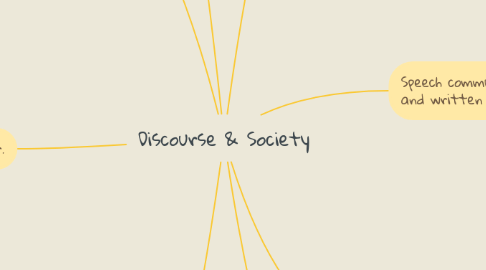
1. Discourse & language choice.
1.1. speakers have for particular communities
1.1.1. social identities
1.1.2. linguistic repertoire
1.1.3. language variety
1.2. dertermined by
1.2.1. the domain language of the situation
1.3. factors
1.3.1. who we are speaking to
1.3.2. social context
1.3.3. topic
1.3.4. interaction's goals
1.3.5. social distance
1.3.6. formality
1.3.7. type of interaction
1.3.8. status
2. Discourse, social class & social newtworks.
2.1. social class
2.1.1. influences discourse
2.1.2. subjective
2.1.3. factors to define it
2.1.3.1. occupation
2.1.3.2. education
2.1.3.3. income
2.1.3.4. housing & location
2.1.3.5. religion
2.1.3.6. communities organizations
2.2. social netwroks
2.2.1. influences the use of language
2.2.2. spoken and written discourse
2.2.2.1. how speakers represent themselves to each others.
3. Discourse & gender.
3.1. Gender
3.1.1. is not something that someone "has", is something that a person "does"
3.1.2. is made through the use of language someone uses.
3.1.3. women language
3.1.3.1. dominance approach
3.1.3.2. difference or cultural approach
3.1.4. men language
3.1.5. neutral language
3.1.6. socially contructed
3.2. relationship
3.2.1. almost always indirect
3.2.2. mediated by something else
4. Discourse & identity.
4.1. A person may have a number of identities
4.1.1. more important at different points in time
4.2. includes
4.2.1. the way people use language
4.2.2. the way people interact
4.2.3. speaker's relationship influence
4.3. Identity
4.3.1. is contructed through discourse
4.3.2. is not fix in a perons's life
4.3.3. constantly constructed and reconstracted
4.3.4. Depends on
4.3.4.1. context
4.3.4.2. purpose
4.3.4.3. occasion
4.3.4.4. space
4.3.4.5. place
4.3.5. is a two-way construction
4.3.5.1. recognize by others participants
4.4. identity in online chat enviroment
4.4.1. use words
4.4.2. symbols
4.4.3. emoticons
4.4.4. images
4.5. identity and casual conversation
4.5.1. people feel relax
4.5.2. spontaneous
4.5.3. more themselves
4.6. identity and written academic discourse
4.6.1. everything we write says something about us
5. Discourse communities and speech communities.
5.1. Discourse communities
5.1.1. a group of people sharing things in commmon and have regular meetings.
5.1.1.1. members
5.1.1.1.1. share
5.1.1.1.2. may be in more than one discourse community
5.1.2. Devitt proposes:
5.1.2.1. groups of language users
5.1.2.1.1. Communities
5.1.2.1.2. collectives
5.1.2.1.3. networks
5.2. both influence
5.2.1. what we say
5.2.2. how we say it
5.2.3. lanuguage variety
6. Speech communities & spoken and written discourse.
6.1. Speech communities
6.1.1. any group of people that speak the same language.
6.1.1.1. members
6.1.1.1.1. share particular norms for communication
6.1.1.1.2. may be in more than one speech community.
6.1.2. requires proximity to convey their language's culture.
6.1.3. Factors to define it
6.1.3.1. language
6.1.3.2. social factors
6.1.3.3. geographical factors
6.1.3.4. cultural factors
6.1.3.5. political factors
6.1.3.6. ethnic factors
6.1.3.7. race
6.1.3.8. age
6.1.3.9. gender
7. Discourse & sexuality.
7.1. relationship
7.1.1. add the notion of desire to the dicussion
7.2. sexuality
7.2.1. has unconscious basis
7.2.1.1. based on desire
8. Discourse & ideology.
8.1. ideologies
8.1.1. tend to be hidden
8.1.2. can be explored/analiyzed
8.1.2.1. by looking
8.1.2.1.1. textual features
8.1.2.1.2. explanation
8.1.2.1.3. interpretation
8.1.2.2. throught
8.1.2.2.1. Framing of the text
8.1.2.2.2. Foregrounding of the text

